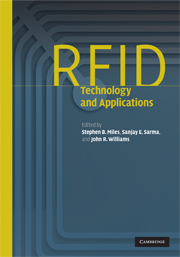Book contents
- Frontmatter
- Contents
- List of contributors
- Preface
- Acknowledgments
- 1 Introduction to RFID history and markets
- 2 RFID technology and its applications
- 3 RFID tag performance optimization: a chip perspective
- 4 Resolution and integration of HF and UHF
- 5 Integrating sensors and actuators into RFID tags
- 6 Performance evaluation of WiFi RFID localization technologies
- 7 Modeling supply chain network traffic
- 8 Deployment considerations for active RFID systems
- 9 RFID in the retail supply chain: issues and opportunities
- 10 Reducing barriers to ID system adoption in the aerospace industry: the aerospace ID technologies program
- 11 The cold chain
- 12 The application of RFID as anti-counterfeiting technique: issues and opportunities
- 13 Closing product information loops with product-embedded information devices: RFID technology and applications, models and metrics
- 14 Moving from RFID to autonomous cooperating logistic processes
- 15 Conclusions
- Appendix – links to RFID technology and applications resources
- Editor biographies
- Index
- References
8 - Deployment considerations for active RFID systems
Published online by Cambridge University Press: 02 November 2009
- Frontmatter
- Contents
- List of contributors
- Preface
- Acknowledgments
- 1 Introduction to RFID history and markets
- 2 RFID technology and its applications
- 3 RFID tag performance optimization: a chip perspective
- 4 Resolution and integration of HF and UHF
- 5 Integrating sensors and actuators into RFID tags
- 6 Performance evaluation of WiFi RFID localization technologies
- 7 Modeling supply chain network traffic
- 8 Deployment considerations for active RFID systems
- 9 RFID in the retail supply chain: issues and opportunities
- 10 Reducing barriers to ID system adoption in the aerospace industry: the aerospace ID technologies program
- 11 The cold chain
- 12 The application of RFID as anti-counterfeiting technique: issues and opportunities
- 13 Closing product information loops with product-embedded information devices: RFID technology and applications, models and metrics
- 14 Moving from RFID to autonomous cooperating logistic processes
- 15 Conclusions
- Appendix – links to RFID technology and applications resources
- Editor biographies
- Index
- References
Summary
In transitioning from the analysis of RFID systems technology to actual deployment considerations of specific sites, the first area confronting project managers is the need to assess the range of other RF applications that may be operating at the same unlicensed frequencies.
A critical part of preparing for RFID system implementations is planning to support the various RFID applications infrastructures that may be implemented. Specifically, the opportunity to leverage a common IT infrastructure for supply chain, pedigree-tracking, and location-tracking RFID services promise higher return from investments in these technologies. One example is to consider levera-ging a wireless data (WiFi) network as the back-haul for RFID readers. Another would be to analyze the costs and benefits of combining RTLS applications with the same WiFi infrastructure, rather than using stand-alone systems for both. At a minimum, a gap analysis is required, in order to assess systems operating across the unlicensed spectrum that might interfere with the performance of RFID systems, or vice versa.
Introduction
Wal-Mart and the Department of Defense's announcement in 2003 mandating their suppliers to implement RFID tagging for all goods supplied to them caused a flurry of panic and speculation on how best to implement this requirement. Other agencies, including the FDA and corporations, have followed suit, with varying timelines and deployment plans. The area of passive RFID is more mature than that of active RFID with respect to the level of standardization and test data.
- Type
- Chapter
- Information
- RFID Technology and Applications , pp. 101 - 112Publisher: Cambridge University PressPrint publication year: 2008
References
- 2
- Cited by



